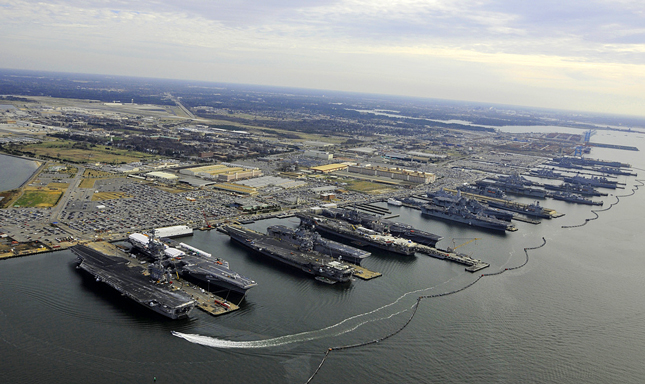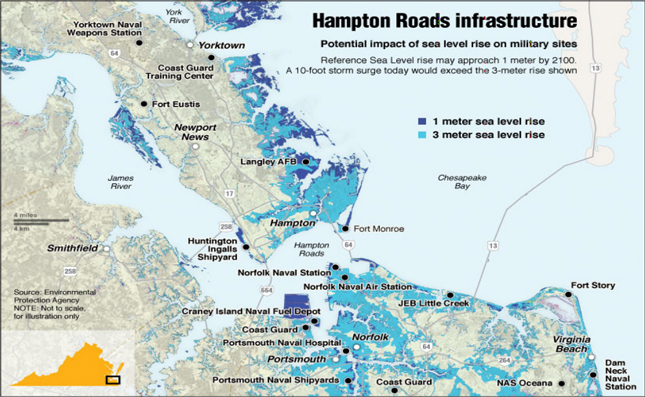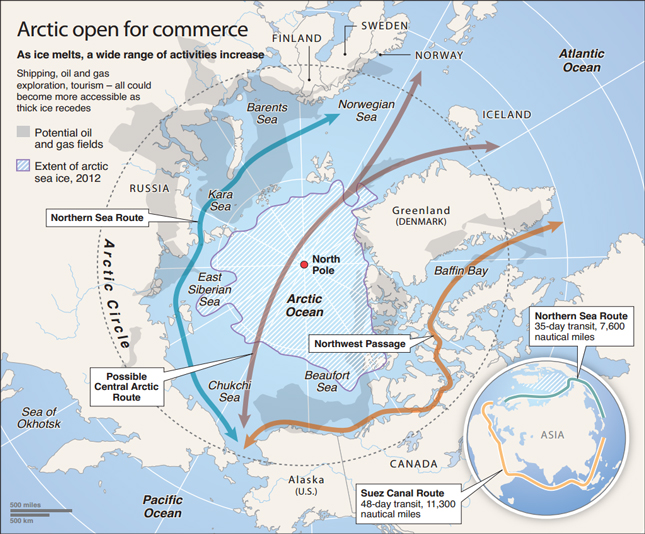-
National Security and the Accelerating Risks of Climate Change (Report Launch)
June 16, 2014 By Benjamin Dills
Climate change poses a serious threat to U.S. national security and is becoming a “catalyst for conflict” in vulnerable countries, according to a panel of retired military leaders speaking at the Wilson Center on May 15. [Video Below]
“What surprised me was how little disagreement there was,” said retired Rear Admiral David Titley. “We plan for everything, and we would be professionally negligent if we were not planning for this kind of magnitude of change in the battlespace.”
Titley spoke alongside three fellow members of the CNA Corporation’s Military Advisory Board for the launch of National Security and the Accelerating Risks of Climate Change, an update to the Board’s 2007 report, which was influential thanks in part to its senior military authors.
“We would be professionally negligent if we were not planning for this kind of magnitude of change in the battlespace”Since 2007, the risks of climate change have increased more rapidly than expected, says the report, authored by 16 retired officers. Rising affluence and the addition of over half-a-billion people to world population have increased pressure on food, water, and energy resources, while severe weather has threatened the infrastructure of military bases and created humanitarian crises, said Retired Vice Admiral Lee Gunn. While the first report called climate change a “threat multiplier,” the authors have elevated their concern, using the term “catalyst for conflict.”
Former U.S. Secretary of Defense Leon Panetta and Former U.S. Secretary of Homeland Security Michael Chertoff write in the update’s forward that the report “serves as a bipartisan call to action.” “We are dismayed that discussions of climate change have become so polarizing and have receded from the arena of informed public discourse and debate,” write the Military Advisory Board (MAB) members.
Rising Seas and Extreme Weather Threaten Readiness
The U.S. military has made efforts before to incorporate climate change into long-term planning, including addressing it in the 2010 and 2014 Quadrennial Defense Reviews, but “we now need to get beyond writing reports and having studies,” said Titley, and make concrete changes in policy and procurement.
The most pressing threat of climate change to U.S. national security is its capacity to disrupt operations at military bases, said Retired General Ron Keys. Some effects have already been seen, according to the report. In the southern and western United States, extreme heat has damaged roads, rail lines, and airport runways, and in the past six years drought has led to insufficient cooling water for power plants in Texas, Georgia, and Connecticut.
Extreme weather also impairs readiness by limiting the days of the year available for training, said Keys. Drought can make the risk of wildfire too high for training sites to be used, and extreme temperatures and storms can make training too dangerous.

As sea levels rise, coastal bases and the civilian infrastructure they depend on will become increasingly vulnerable to flooding and storm surges, with Keys noting that a Department of Defense assessment found that at least 30 bases were vulnerable. The low-lying Hampton Roads area of Virginia, which has 29 military sites as well as industrial facilities and civilian infrastructure that are essential to the U.S. military, is particularly threatened. The installations at risk include Naval Station Norfolk, the largest naval complex in the world, and the Huntington Ingalls Shipyard, which builds half of the U.S. Navy’s submarines and all of its aircraft carriers.
Humanitarian and Crisis Response
Responding to climate change may also create new operational burdens for the military. When severe weather strikes particularly vulnerable areas, as Typhoon Haiyan and Hurricane Sandy showed, the results can be devastating and the U.S. military is often among the first responders. In March before Haiyan struck the Philippines, killing thousands, Admiral Samuel J. Locklear III, head of U.S. Pacific Command, called climate change the biggest long-term threat to security in the region, citing the increased number of severe typhoons as one of the ways this challenge would manifest.
The increasing need for humanitarian response, both internationally and domestically, will strain the capabilities of the U.S. military, according to Gunn. The National Guard, as well as the Army Corps of Engineers and the Army Reserves, provide critical support for the active-duty military when it deploys, including capabilities that only those units possess, says the report. The more they are needed to aid in natural disaster response and humanitarian interventions, the less these capabilities will be available for other types of deployments.
Besides more humanitarian missions, the MAB also expects climate change to lead to increased tensions and potentially more conflict. Gunn said the Arab Spring and the Syrian Civil War are examples of crises that climate change influenced, pointing out that drought in Russia and China presaged a global food price spike in 2011 and Syria endured five years of devastating drought before war broke out. He was careful to note that climate change was not the primary cause of upheaval, but it may have been a catalyst.
Retired Rear Admiral (U.K.) Neil Morisetti said the equatorial regions of the world are particularly susceptible to disruptions caused by increasing extreme weather, drought, sea-level rise, and desertification since they are already more vulnerable to these problems and many governments are less able to cope.
New Arctic Missions
Perhaps no region is experiencing more rapid physical changes than the Arctic. Gunn and Keys noted that melting is opening up new sea lanes and areas for resource extraction where before there was only ice. Patrolling these sea lanes and engaging in the inevitable rescue operations will require the Navy to adapt and expand its capabilities.
The Arctic Security Forces Roundtable, held last year, brought together one- and two-star level military leaders from all the Arctic nations to discuss how they would coordinate and support civilian authorities in case of an emergency. Such military-to-military engagement can build trust to facilitate cooperation in more contentious areas. “There are lots of things many people can agree upon,” said Titley, who served as director of the Navy’s 2009 Task Force Climate Change. “So let’s do those now, and then as we build trust and confidence in each other, then you can progressively tackle the harder parts.”
“The Ice Doesn’t Care About Politics”
There are other incremental steps being taken to increase resilience, said Acting Deputy Under Secretary of Defense for Installations and Environment John Conger. The Department of Defense is conducting comprehensive surveys of bases to verify that they are assessing and reinforcing their power and water supplies. He said that where bases are in flood prone areas, he’s “directed them to certify they’re taking mitigation action: don’t put your backup power in the basement; don’t put your servers in the basement. There are sensible and reasonable steps that one can take if only one acknowledges that the risk exists.”
Weighing risks and uncertainties is part of the jobBut there are limits to what the military can do without comprehensive political support, said Keys. The Base Closure and Realignment process requires congressional approval; without it, large-scale adjustment of the military’s infrastructure is not possible. Titley reiterated the report’s call to action. “Let your leadership know you’re interested,” he said, “ask them how they intend to help stabilize the climate.”
The MAB’s emphasis on stronger language about the potential for climate change to “catalyze conflict” is interesting considering how unsettled the academic debate is about the links between climate change and conflict. However, the authors’ concern can be attributed in part to their unique perspectives. The report was written from the point of view of military operators, senior military leaders “who have to deal with the battlespace as it is,” said Titley. Weighing risks and uncertainties is part of the job. As Retired Admiral Frank Bowman writes, “even very low probability events with devastating consequences must be considered and mitigation/adaptation schemes developed and employed.”
Even if the U.S. military isn’t necessarily called on to fight more wars, its mission envelope is likely to expand as it responds to more humanitarian disasters and the Arctic opens up, while readiness is threatened by infrastructure adjustments. “Ultimately, the data wins; the observations win,” said Titley. “The ice doesn’t care about politics or Democrats and Republicans; it just melts.”
Event Resources:
Sources: The Boston Globe, CNA Corporation.
Photo Credit: Aircraft carriers and amphibious ships moored in Norfolk, Virginia, courtesy of Ernest R. Scott/U.S. Navy. Maps courtesy of CNA Corporation.
 A Publication of the Stimson Center.
A Publication of the Stimson Center.





